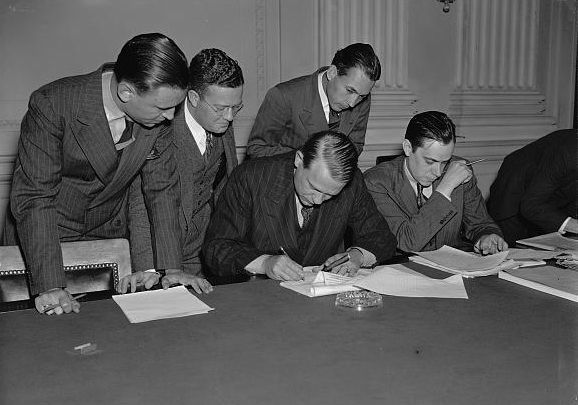"McCarthy" is a trigger word to many, and the larger damage is how it is mis-applied and mis-used. This is especially true in the case of the Leftist political ideologies which in usual have vague and imprecise techniques they use, the term "McCarthyism"~etc. has been applied to many things it was not!
Too often McCarthyism is blended with/confused with something in play before and after McCarty was on the stage.
...
The
House Committee on Un-American Activities (
HCUA), popularly the
House Un-American Activities Committee (
HUAC), was an investigative
committee of the
United States House of Representatives, created in 1938 to investigate alleged disloyalty and subversive activities on the part of private citizens, public employees, and those organizations suspected of having
fascist and
communist ties. It became a standing (permanent) committee in 1946, and from 1969 onwards it was known as the
House Committee on Internal Security. When the House abolished the committee in 1975,
[1] its functions were transferred to the
House Judiciary Committee.
The committee's anti-communist investigations are often associated with
McCarthyism, although
Joseph McCarthy himself (as a
U.S. Senator) had no direct involvement with the House committee.
[2][3] McCarthy was the chairman of the
Government Operations Committee and its
Permanent Subcommittee on Investigations of the U.S. Senate, not the House.
...
In 1947, the committee held nine days of hearings into alleged communist propaganda and influence in the
Hollywood motion picture industry. After conviction on
contempt of Congress charges for refusal to answer some questions posed by committee members, "
The Hollywood Ten" were
blacklisted by the industry. Eventually, more than 300 artists – including directors, radio commentators, actors, and particularly screenwriters – were boycotted by the studios. Some, like
Charlie Chaplin,
Orson Welles,
Alan Lomax,
Paul Robeson, and
Yip Harburg, left the U.S or went underground to find work. Others like
Dalton Trumbo wrote under
pseudonyms or the names of colleagues. Only about ten percent succeeded in rebuilding careers within the entertainment industry.
....

en.wikipedia.org
........
Many, and most often it is the Left~pseudo-LIberals, conflate the HUAC with McCarthy and "McCarthyism". The two were distinct and different however. Aside from the longer duration of HUAC compared to McCarthy's activities, a major difference is focus.
McCarthy was focused on Communist 'agents' within the Federal Government*, Civil and Military; whereas HUAC focused mainly in other parts of American society, mostly the entertainment industries; actors, writers, etc.
* While many, mostly on the Left, would minimumize McCarthy's focus and efforts as being fabrications, it turns out that years later, when the Vernona Project was declassified, that many on McCarthy's 'List' actually were agents for the Soviets.
...
The
Venona project was a United States
counterintelligence program initiated during World War II by the United States Army's
Signal Intelligence Service and later absorbed by the
National Security Agency (NSA), that ran from February 1, 1943, until October 1, 1980.
[1] It was intended to decrypt messages transmitted by the
intelligence agencies of the
Soviet Union (e.g. the
NKVD, the
KGB, and the
GRU).
[2] Initiated when the Soviet Union was an ally of the US, the program continued during the
Cold War, when the Soviet Union was considered an enemy.
During the 37-year duration of the Venona project, the Signal Intelligence Service decrypted and translated approximately 3,000 messages.
[3] The
signals intelligence yield included discovery of the
Cambridge Five espionage ring in the United Kingdom,
[4] and also of Soviet espionage of the
Manhattan Project in the US,
[5] known as Project Enormous. Some of the espionage was undertaken to support the
Soviet atomic bomb project.
[6] The Venona project remained secret for more than 15 years after it concluded. Some of the decoded Soviet messages were not
declassified and published by the United States until 1995.
...
For much of its history, knowledge of Venona was restricted even from the highest levels of government. Senior army officers, in consultation with the FBI and CIA, made the decision to restrict knowledge of Venona within the government (even the CIA was not made an active partner until 1952). Army Chief of Staff
Omar Bradley, concerned about the White House's history of leaking sensitive information, decided to deny President Truman direct knowledge of the project. The president received the substance of the material only through FBI, Justice Department, and CIA reports on counterintelligence and intelligence matters. He was not told the material came from decoded Soviet ciphers. To some degree this secrecy was counter-productive; Truman was distrustful of FBI head
J. Edgar Hoover and suspected the reports were exaggerated for political purposes.
Some of the earliest detailed public knowledge that Soviet code messages from World War II had been broken came with the release of
Chapman Pincher's book,
Too Secret Too Long, in 1984.
Robert Lamphere's book,
The FBI-KGB War, was released in 1986. Lamphere had been the FBI liaison to the code-breaking activity and had considerable knowledge of Venona and the
counter-intelligence work that resulted from it. However, the first detailed account of the Venona project, identifying it by name and making clear its long-term implications in post-war espionage, was contained in MI5 assistant director
Peter Wright's 1987 memoir,
Spycatcher.
Many inside the NSA had argued internally that the time had come to publicly release the details of the Venona project, but it was not until 1995 that the
bipartisan Commission on Government Secrecy, with Senator Moynihan as chairman, released Venona project materials. ...
...

en.wikipedia.org
~~~~~~~~~~~~~~~
As we see all too often here, ignorance drives many mis-conceptions and 'fake news'.


